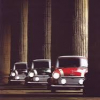Performance Figures?
#1

Posted 11 September 2009 - 08:12 PM
#2

Posted 11 September 2009 - 08:33 PM
#3

Posted 11 September 2009 - 08:39 PM
If you want to know your power output, torque, bhp etc.... go to a rolling road and get a printout - no two cars are the same, even if in apparently similar condition.
#4

Posted 11 September 2009 - 08:50 PM

#5

Posted 11 September 2009 - 09:06 PM
does anyone know what the performance figures and dimensions are for the 1989 998cc mini racing
I have never seen any 0-60 times published for Mini 7 cars.
The emphasis in designing the rules for Mini 7 engines is to reduce cost and promote reliability.
You have to recognize that the Mini 7 rules for 998 engine preparation are extremely restrictive.
Even with such restrictive rules, these Mini 7 998 engines can put out as much 80 HP on the brake.
They often see 8500 RPM and sometimes more.
The following is taken from the Mini 7 Technical Regulations. The CAM6648 cam is the MG Metro cam.
Mini 7 engines typically run one barrel of a Weber DCOE carb and a mild compression ratio.
MINI SEVEN ONLY.
i) A production Rover Cars ‘A’ series 5 port head casting must be fitted which may be modified by polishing and machining to
combustion chambers, ports and machined faces
ii) Exhaust manifolds are free
iii) Standard ‘A’ series 998cc cylinder block is mandatory
Bore 64.58mm x Stroke 76.2mm (2.543” x 3.00”)
iv) Maximum bore size permitted 65.08mm/2.563”
v) Any production Rover Cars crankshaft with standard stroke 76.20mm (3.00”) except Cooper “S” is permitted
vi) Camshaft. Either the unmodified M7 6648 camshaft (obtainable via Mike Garton) or the unmodified Rover camshaft part
number CAM6648 is permitted. Cam Lift: Inlet 0.250"/6.35mm, Exhaust 0.252"/ 6.40mm
Timing:
Inlet opens - 16° B.T.D.C. Inlet closes - 56° A.B.D.C.
Exhaust opens - 59° B.B.D.C. Exhaust closes - 29° A.T.D.C.
A: Inlet 27.66mm. Exhaust 27.93mm. B: 34.35mm.
Set valve clearance to 0.021”, clearance to check timing.
Set valve clearance to 0.015” 0.4mm to check lift.
It is permitted to weld reinforce pressed steel type rockers on the top surface to minimise flexing.
vii) Rocker assemblies are free but must conform to the maximum valve lift 0.330”/8.38mm.
viii) Pistons must be either Rover Cars
ix) ADU 4203 (Dished, floating pin).
x) TAM 2052 (Flat top interference pin).
xi) TAM 2054 (Dished, interference pin).
xii) AE/Hepolite 20773 dished (fully floating g/pin).
xiii) Omega 3780 dished, fully floating g/pin.
xiv) Omega 3780F flat top, fully floating g/pin.
These are standard bore size part numbers.
A maximum oversize of 0.020”/0.50mm is permitted.
Strongly recommended to replace the old pattern fully floating rods/piston with the latest interference type. During engine
rebuilds, pistons should always be discarded.
xv) Piston crown may be machined to suit block height a maximum 0.025”/0.63mm.
Minimum distance from crown to top land 0.270”/6.86mm.
xvi) Minimum unswept volume is 24.0cc.
For example
Cylinder Head Combustion Chamber. 12.2cc.
Cylinder Head Gasket. 3.8cc
Minimum piston dish and cylinder volume (at TDC) 8.0cc.
Total (minimum unswept volume) = 24.0cc.
i.e. if cylinder/piston volume is less, the combustion chamber must increase and vice versa.
xvii) Any single choke carburettor is permitted. A multi choke carburettor is permitted provided only one choke is operational.
xviii) A single restrictor of maximum bore 1.5”/38.1mm fitted between the carburettor and manifold is mandatory. The restrictor
must maintain the maximum bore over a minimum width of 3mm/0.12”. The restrictor must be made of non-porous material. Total
length is free.
xix) The ignition distributor must be mounted in its original position. Ignition advance/retard must only be controlled by ‘bob
weights’, spring, and/or vacuum means within the distributor. The low tension switching of the ignition system shall only be with a
contact breaker or contact less system (i.e. Hall effect or light sensitive system) housed within the distributor body.
xx) Further Modifications are free.
xxi) Only Rover Cars ferrous ‘A’ series con rods with original centres (5.75”/146.06mm) are permitted (includes Cooper S).
Titanium is prohibited.
#6

Posted 11 September 2009 - 09:13 PM
mini7boy - that is some serious knowledge, how much does it cost to get into mini 7 racing.
#8

Posted 12 September 2009 - 01:39 AM
follow this link: http://www.mini7.co.uk/classified.aspcheers taffy, that was exactly what i wanted, you're a star
mini7boy - that is some serious knowledge, how much does it cost to get into mini 7 racing.
there you will find several adverts for Mini 7 cars for sale.
elsewhere on the site, under "calendar", you'll see that their racing season ends with the Sept. 26-27 races at Snetterton.
I expect that some more cars will come up for sale after the season ends.
Have you attended any races? You may know that Snetterton is in Norfolk near the town of Norwich.
See directions/info for Snetterton at: http://www.motorspor...ton/find-us.asp
Snetterton is a cool circuit. Nice long straights and good passing opportunities make for good racing.
Here is a good Beginner's Guide put out by the Mini 7 Racing club: http://www.mini7.co......ide net_1.pdf
If you haven't seen it already, a good book on all aspects of racing Minis is: http://www.amazon.co...g...081&sr=8-14
Sollis was twice the winner of the Mini 7 Championship and won the Mini Miglia Championship once, I believe. He writes about all areas of building and driving a winning Mini 7 car.
I have this book and it is a super useful resource for anyone interested in Mini racing.
Here's a good video of Mini racing(but not Mini 7 or Miglia) at Snetterton: http://www.youtube.c...U...PL&index=17
This video from Snetterton is excellent, but may only be available for Mini 7 club members. Try it out, though: http://www.mini7.co.uk/video3.asp
Edited by mini7boy, 12 September 2009 - 02:00 AM.
1 user(s) are reading this topic
0 members, 1 guests, 0 anonymous users
















